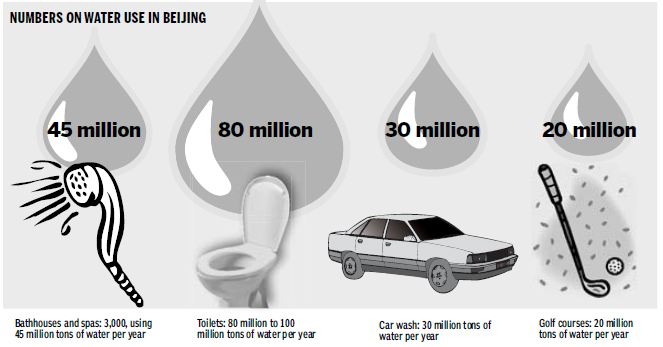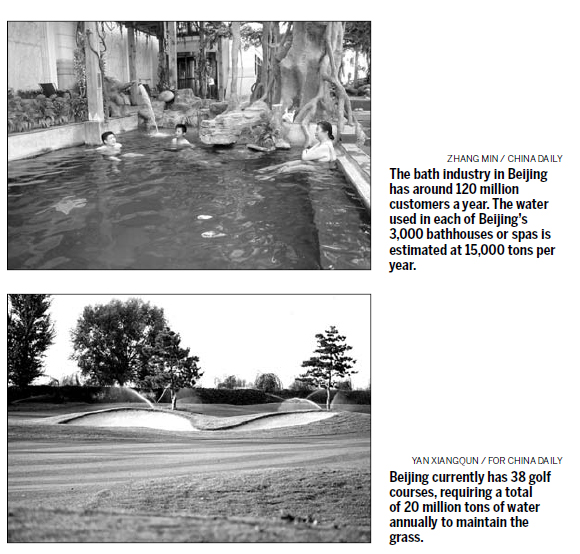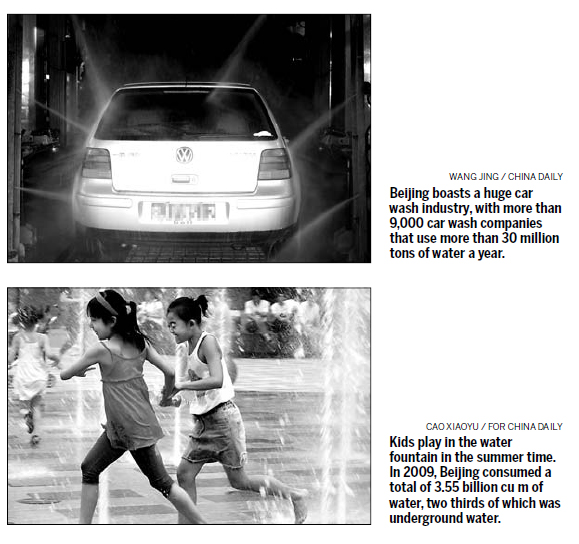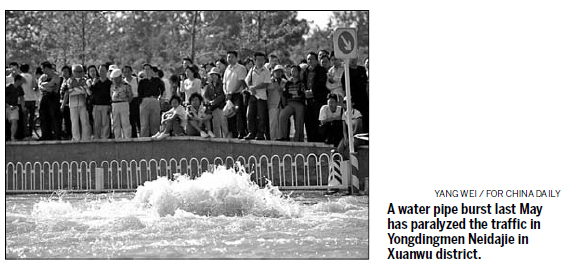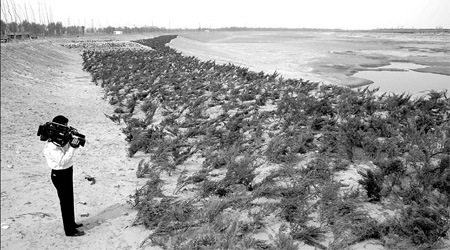Focus
Thirsty city greedily consuming water
By Meng Jing (China Daily)
Updated: 2010-04-06 07:57
 |
Large Medium Small |
|
Recent statistics from the Beijing Water Conservation Office show the city has experienced a long and serious dry spell since 1999, during which rainfall declined 20 percent, and usable water resources were cut by 48 percent. The picture shows trees were planted in the dry riverbed of Beijing's Chaobai river in 2007 to prevent desertification. Liu Jie / for China Daily |
People who have just arrived in Beijing may be surprised to learn that the city is facing a major water shortage.
Surprised, not least because Beijingers can now soak in water any time anywhere across the city at any one of more than 3,000 spas and bathhouses, compared with just 39 at the end of 1989.
Bathers can pamper themselves with milk spas, flower spas, natural spring spas, lava rock spas, and fish spas that use tiny fish to nibble away dead skin. The water used in each bathhouse or spa is estimated at 15,000 tons per year.
The statistics on other uses of water are also startling. For example, the city uses 80 to 100 million tons of water to flush its toilets per year. And Beijing boasts a huge car wash industry, with more than 9,000 car wash companies that use more than 30 million tons of water a year.
But behind this lavish use of water is the grim reality that while the economy booms and living standards and water consumption rise Beijing has been plagued by a 10-year drought, and the city has been desperately sucking up all the water it can.
Recent statistics from the Beijing Water Conservation Office show the city has experienced a long and serious dry spell since 1999, during which rainfall declined 20 percent, and usable water resources were cut by 48 percent.
Some media reports state the average Beijinger has 248 cu m of water at their disposal each year, about one eighth of the national level and far below the internationally recognized guideline of 1,000 cu m, according to the Beijing municipal commission of development and reform.
According to the recently published Annual Report on Environment Development of China (Green Book 2010), if all the 17 million residents in Beijing indulge themselves just once a month in public bathhouses, using 0.4 tons of water a time, the water used in bathing alone will be reaching 81.6 million tons a year. That's equal to the water capacity of 41 Kunming Lakes.
However, the bath industry in Beijing has around 120 million customers a year and generates at least 10 billion yuan annually, according to the Beijing Bath Trade Association.
Though the secretary-general of the association, He Peiyun, insisted the industry provides a necessary service and creates jobs for about 100,000 people, some environmentalists still believe Beijing cannot afford such an extravagant use of water.
"The bathing industry has done nothing wrong. It is just that it is something not suitable for a thirsty city like Beijing," Hu Kanping, the deputy chief editor of the magazine, Environmental Protection, and the co-writer of the Green Book 2010, told METRO.
"People in other countries have a kettle of water; people in China have a cup of water. But people in Beijing have a sip of water," explained Hu."
Water shortages have spurred the drilling of new wells in the city. In 2009, Beijing consumed a total of 3.55 billion cu m of water, two thirds of which was underground water.
"In 1999 you could find water at an average level of 12 meters underground, but in 2008, you needed to dig 23 meters underground. From 1999 to 2008, Beijing has overused 5.6 billion cu m of underground water," said Wang Shan, a researcher at the Beijing Institute of Water.
"Though the government has tried to cut back on the use of underground water, it must satisfy the needs of the population first. The city's water supply is decreasing while the need of the public is increasing, how to make the public use less water is essential for the government," she added.
Wang Jian, a water specialist with Green SOS, an NGO based in Beijing, said the use of underground water shouldn't exceed more than 2.1 billion cu m a year to be sustainable.
"More than 2.1 billion cu m a year is over-exploitation of the underground water," said Wang, who has studied the use of water in Beijing since the 1970s.
Unfortunately, statistics from the Beijing Institute of Water show that, from 1990 to 2007, the use of underground water in Beijing ranged from 2.5 billion cu m to 2.7 billion cu m a year.
To encourage more frugal use, late last year Beijing raised water prices for commercial and industrial use by 11 to 50 percent and offered a one-time increase from 3.7 yuan to 4.6 yuan per cubic meter for residential use.
But Wang Jian believes that with the development of the city, Beijing has attracted more and more rich people to move into the city.
"The slight increase in water price will hardly make them using less water," he commented.
To meet the growing demand the government is transferring water from the south of the country, the first phase of the middle line of the South-to-North Water Diversion will be completed in 2013 and the first southern water is expected to reach Beijing in 2014.
But even with this additional supply learning to use less water is a tough lesson Beijingers will have to learn.
